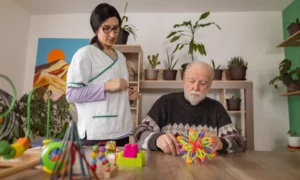Understanding and managing attachment styles is crucial in a world where interpersonal connections play a pivotal role in our well-being. Anxious attachment, characterized by fear of abandonment and an overwhelming need for reassurance, can significantly impact an individual’s mental health and relationships. This article talks about the CBT techniques used for treating anxious attachment, its benefits, tips to find the right CBT therapist near you and more.
Contents
Understanding Anxious Attachment 
Anxious attachment is a psychological and emotional relationship style characterized by a heightened sensitivity to the perceived availability and responsiveness of others, particularly in close relationships. This attachment style is one of the three main styles identified in attachment theory, a psychological framework developed to understand how individuals form emotional bonds with others, especially in early childhood.
Key characteristics of individuals with anxious attachment include:
- Fear of Abandonment
Those with anxious attachment often fear being abandoned or rejected by their loved ones. This fear may lead to heightened vigilance about the status of their relationships. - Seeking Reassurance
Individuals with anxious attachment may seek frequent reassurance from their partners to alleviate their fears and anxieties. They may constantly seek confirmation of their partner’s love and commitment. - Intense Emotional Responses
People with anxious attachments may experience intense emotional reactions to relationship challenges. They may become highly distressed by perceived threats to the relationship, even if those threats are not objectively significant. - Dependency on Others for Emotional Regulation
Individuals with anxious attachment may rely heavily on their partners for emotional regulation. They may struggle to soothe themselves during times of stress and may look to their partners for comfort. - Tendency to Hyperfocus on Relationships
There is often a preoccupation with the relationship, and individuals with anxious attachment may tend to hyperfocus on the emotional dynamics, constantly analyzing and worrying about the state of the relationship. - Difficulty Trusting Others’ Intentions
Trust issues are common, with a tendency to interpret ambiguous situations in a negative light. There may be persistent doubt about the intentions and feelings of others.
Anxious attachment typically stems from early life experiences, especially those related to inconsistent caregiving, neglect, or early separations from caregivers. While it can manifest in various relationships, it is often most pronounced in romantic partnerships.
Introduction To Cognitive Behavioral Therapy (CBT)
Cognitive Behavioral Therapy (CBT) is a widely practiced and evidence-based form of psychotherapy that focuses on identifying and changing negative thought patterns and behaviours. Developed on the premise that our thoughts, feelings, and behaviours are interconnected, CBT aims to help individuals understand and alter unhelpful cognitive patterns to achieve positive changes in emotions and actions.
Key components of Cognitive Behavioral Therapy include:
- Cognitive Restructuring
CBT recognizes the impact of negative thought patterns on emotions and behaviours. Through cognitive restructuring, individuals learn to identify and challenge distorted or irrational thoughts, replacing them with more balanced and realistic ones. - Behavioural Techniques
CBT places a strong emphasis on behaviour and action. Therapists work with clients to develop and implement strategies that encourage positive behaviours and reduce negative ones. This may involve behavioural experiments, exposure therapy, or skills training. - Goal-Oriented and Problem-Solving Approach
CBT is often structured and goal-oriented. Clients and therapists collaborate to set achievable goals and develop strategies to address particular challenges. The focus is on practical problem-solving and skills development. - Homework Assignments
CBT often includes homework assignments between sessions. These assignments may involve practicing new skills, keeping a journal, or applying strategies learned in therapy to real-life situations. Homework reinforces the therapeutic process and helps clients integrate new behaviours into their daily lives. - Therapeutic Relationship
While CBT is structured and goal-focused, the therapeutic relationship remains crucial. Therapists provide support, guidance, and feedback, creating a collaborative and trusting environment for clients to explore and address their challenges.
CBT has been proven effective in treating a wide range of mental health issues, including anxiety disorders, depression, post-traumatic stress disorder (PTSD), eating disorders, and more. Its structured and practical nature makes it suitable for short-term, goal-focused therapy, and it is often used in conjunction with other therapeutic approaches.
CBT Techniques For Individuals With Anxious Attachment 
- Cognitive Restructuring
CBT begins by unravelling the intricate web of negative thought patterns that contribute to anxious attachment. Through cognitive restructuring, individuals learn to challenge and reframe irrational beliefs, paving the way for more constructive thinking.
- Exposure Therapy
Facing fears and anxieties head-on is a crucial aspect of CBT for anxious attachment. Exposure therapy gently guides individuals to confront their attachment-related fears, gradually diminishing their emotional intensity.
- Mindfulness Exercises
CBT incorporates mindfulness practices to enhance self-awareness and promote emotional regulation. Mindfulness exercises provide individuals with the tools to stay present and manage their emotional responses in challenging situations.
Benefits Of CBT For Anxious Attachment
Cognitive Behavioral Therapy (CBT) can offer several benefits for individuals with anxious attachment. Here are some of the key advantages:
- Increased Self-Awareness
CBT encourages individuals to explore and understand their thought patterns, emotions, and behaviours which helps individuals recognize the impact of anxious attachment on their relationships. - Identification and Restructuring of Negative Thoughts
CBT provides tools to identify and challenge negative thoughts associated with anxious attachment. - Improved Emotional Regulation
Anxious attachment is often linked to heightened emotional reactions. CBT equips individuals with strategies to regulate their emotions, reducing the intensity of anxious feelings and promoting emotional balance. - Enhanced Coping Skills
Individuals learn adaptive ways to cope with relationship challenges, reducing reliance on maladaptive coping mechanisms. - Behavioural Changes
Through behavioural interventions, CBT helps individuals modify patterns of behaviour associated with anxious attachment. This may include addressing avoidance behaviours, increasing social engagement, and fostering healthier relationships. - Increased Confidence and Self-Esteem
As individuals experience success in managing their anxious attachment, their confidence and self-esteem can grow. - Enhanced Communication Skills
CBT often includes communication skills training, helping individuals express their needs, thoughts, and feelings more effectively. - Development of Secure Attachment Traits
By addressing underlying issues and working on building a secure internal working model, CBT can contribute to the development of secure attachment traits. - Long-Term Relapse Prevention
CBT equips individuals with skills that extend beyond the therapy sessions. This can contribute to long-term relapse prevention by providing tools to navigate future relationship challenges and stresses. - Enhanced Relationship Satisfaction
As individuals with anxious attachment learn to manage their anxieties and develop healthier relationship patterns, they often experience increased satisfaction in their interpersonal connections.
Finding The Right CBT Therapist 
Finding a Cognitive Behavioral Therapist (CBT) for anxious attachment involves a series of steps to ensure you connect with a qualified and suitable professional. Here’s a guide on how to find a CBT therapist for anxious attachment:
- Ask for Recommendations
Seek recommendations from friends, family, or healthcare providers. Personal referrals can provide valuable insights into the therapist’s approach and effectiveness. - Online Directories
Utilize online therapy directories, such as MantraCare, TherapyMantra, or GoodTherapy which allow you to search for therapists based on location, specialties, and treatment modalities. - Professional Associations
Explore websites of professional associations like the Association for Behavioral and Cognitive Therapies (ABCT) or your country’s psychological associations. - Online Therapy Platforms
Consider online therapy platforms such as MantraCare, TherapyMantra, or other reputable services that connect individuals with licensed therapists. - Check Credentials
Ensure the therapists are licensed to practice in your jurisdiction and have specific training or experience in Cognitive Behavioral Therapy. - Initial Consultation
Schedule an initial consultation with the therapist. This is an opportunity to discuss your concerns, ask questions about their therapeutic approach, and assess if you feel comfortable working with them. - Cost and Logistics
Clarify the cost of sessions and any logistical details, such as session duration and frequency. Discuss payment options, insurance coverage, or sliding scale fees if applicable. - Trust Your Instincts
Trust your instincts during the process. A good therapeutic relationship is built on trust and collaboration. If you don’t feel a connection with the therapist, it’s okay to explore other options.
Finding the right therapist is a personal journey, and it may take some time to find the best fit. Prioritize open communication, professionalism, and a shared commitment to addressing anxious attachment through CBT techniques.
CBT Techniques You Can Practice At Home 
Cognitive Behavioral Therapy (CBT) techniques can be practiced at home to help manage various mental health concerns. Here are some CBT techniques that you can try on your own:
- Journaling
- Write down thoughts, emotions, and behaviours.
- Track negative patterns and identify triggers.
- Thought Records
- Note situations causing stress.
- List automatic negative thoughts.
- Challenge and reframe those thoughts.
- Mindfulness Meditation
- Stay present in the moment.
- Focus on breathing or guided meditations.
- Reduce anxiety and enhance self-awareness.
- Graded Exposure
- Face fears gradually.
- Start with less anxiety-inducing situations.
- Build confidence over time.
- Behavioural Activation
- Engage in enjoyable activities.
- Create a schedule for routine and accomplishment.
- Coping Cards
- Write positive affirmations.
- Include calming statements.
- Refer to them during stress.
- Challenge Catastrophizing
- Identify and challenge worst-case scenarios.
- Look for evidence supporting alternative perspectives.
- Positive Self-Talk
- Monitor self-talk for negativity.
- Replace with positive affirmations.
- Encourage and support yourself.
- Relaxation Techniques
- Practice deep breathing.
- Try progressive muscle relaxation.
- Manage physical symptoms of anxiety.
- Goal Setting
- Set realistic, achievable goals.
- Break larger goals into smaller steps.
- Celebrate accomplishments.
- Social Skills Practice
- Improve communication skills.
- Practice active listening and assertiveness.
- Role-play social situations.
- Mind-Body Connection
- Exercise regularly.
- Ensure adequate sleep.
- Maintain a balanced diet.
- Time Management
- Break tasks into smaller components.
- Prioritize and allocate time effectively.
- Reduce stress through better time management.
- Consistency is Key
- Practice techniques regularly.
- Start with a few and gradually add more.
- Seek professional help if needed.
Remember, these techniques are tools for self-help, but seeking guidance from a mental health professional is always an option for more personalized support.
Conclusion
In conclusion, Cognitive Behavioral Therapy stands as a beacon of hope for individuals grappling with anxious attachment. Its ability to address the intricacies of negative thought patterns, emotional bursts, and individual specificity makes it a powerful tool for unlocking emotional freedom.
If you are experiencing anxiety-related issues, Online Anxiety Counseling at TherapyMantra can help: Book a trial Online therapy session.






